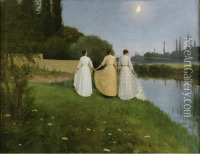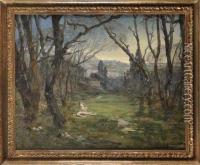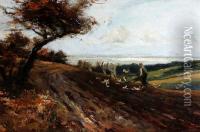Georges Girardot Paintings
Georges Girardot was a French artist, known primarily for his genre paintings and portraits. Born in 1856 in Langres, Haute-Marne, France, he belonged to the period of art that saw the transition from traditional academic painting to the burgeoning Impressionist movement. Despite this transformative era in art history, Girardot remained largely influenced by the academic style, which is characterized by its focus on realistic representation and often historical or mythological subject matters.
Girardot was a student at the École des Beaux-Arts in Paris, where he was trained in the rigorous academic tradition. He studied under well-known figures such as Alexandre Cabanel, a painter famous for his historical and mythological works, and William-Adolphe Bouguereau, whose polished style and focus on the female form had a considerable influence on Girardot's own art.
While Girardot's work did not reach the same level of fame as some of his contemporaries, he was nevertheless a respected artist in his time. He exhibited at the Salon, the official art exhibition of the Académie des Beaux-Arts in Paris, which was the preeminent place for artists to show their work in the 19th century. His paintings typically depicted scenes of everyday life, portraits, and occasionally historical events, rendered with a high degree of skill and attention to detail.
Georges Girardot's career was a reflection of the tastes of the bourgeois clientele of the late 19th century, who appreciated the beauty, craftsmanship, and often moralistic narratives of academic art. Despite the overshadowing influence of Impressionism and Post-Impressionism during his lifetime, Girardot remained committed to his style until his death in 1914, just as the world was on the brink of the First World War. While he may not be as widely remembered as some of his contemporaries, Girardot's works are part of the rich tapestry of French art history and offer insight into the aesthetic preferences and cultural values of his time.





